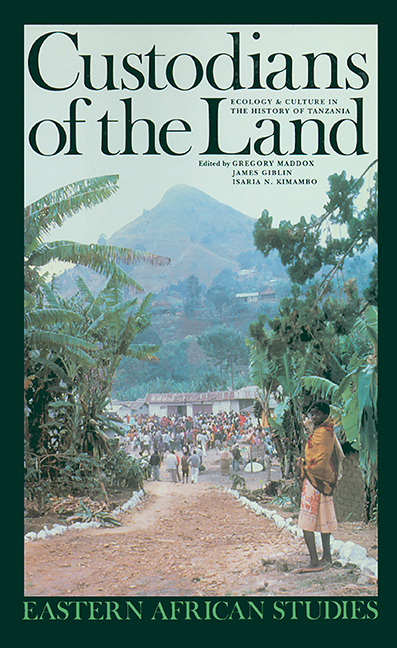Book contents
- Frontmatter
- Contents
- List of Maps, Figures & Tables
- List of Photographs
- Abbreviations
- Contributors
- Acknowledgements
- Introduction Custodians of the Land: Ecology & Culture in the History of Tanzania
- Part One Environmental & Demographic Change
- One Population: A Dependent Variable
- Two Environment & Population Growth: In Ugogo, Central Tanzania
- Part Two Environmental Change & Economic History: In Tanzania's Northern Highlands
- Part Three Politics & Environmental Change
- Part Four Environment & Morality
- Conclusion
- Bibliography
- Index
One - Population: A Dependent Variable
from Part One - Environmental & Demographic Change
Published online by Cambridge University Press: 30 August 2017
- Frontmatter
- Contents
- List of Maps, Figures & Tables
- List of Photographs
- Abbreviations
- Contributors
- Acknowledgements
- Introduction Custodians of the Land: Ecology & Culture in the History of Tanzania
- Part One Environmental & Demographic Change
- One Population: A Dependent Variable
- Two Environment & Population Growth: In Ugogo, Central Tanzania
- Part Two Environmental Change & Economic History: In Tanzania's Northern Highlands
- Part Three Politics & Environmental Change
- Part Four Environment & Morality
- Conclusion
- Bibliography
- Index
Summary
The intricate interrelations between population and economic and social development continue to cause controversy in Tanzania as elsewhere in Africa. Perceptions about them have also changed. Indeed, like population growth itself, the present preoccupation with rapid population growth and the concomitant environmental stress caused by human activity is a relatively recent phenomenon in Africa. Under colonial rule, because little population increase appeared to take place, the major worry of colonial governments was underpopulation and inefficient exploitation of the environment, for small populations were regarded as being unable to gain ascendancy over nature. Thus, when population growth became evident in the late colonial period, it was welcomed and taken as a proof of the benefits conferred by European rule and Western civilization. In the present, the view that population growth fosters development has not completely withered away, but it has largely been superseded by the view that population growth causes poverty and environmental degradation.
Underlying these changing perceptions of the developmental role of population growth are more diffuse opinions concerning its basic causes and mechanism. Few people would continue to argue that European colonialism ‘saved’ ‘the lives of millions of men who under the old conditions would have died early in childhood, or in later life, of famine, disease and violence’. Yet many people continue to assume that population growth should indeed be credited to the intervention of development efforts during and after colonial rule. The disagreement is about how such intervention actually influenced demographic change. One influential view claims that development merely did away with physical and biological constraints which were impeding population growth. Here, population is understood in Malthusian fashion as an ‘independent variable’, a biologically grounded ‘ecological’ factor which creates its own momentum once the physical shackles restraining its growth have been cut by biomedical or other development intervention. An alternative perspective, however, sees development intervention producing a profound restructuring of economic and social relations which is conducive to demographic growth. Here, demographic variables are seen as ‘dependent’, and population growth emerges as a consequence of the workings of other social, economic and cultural forces.
- Type
- Chapter
- Information
- Custodians of the LandEcology and Culture in the History of Tanzania, pp. 19 - 42Publisher: Boydell & BrewerPrint publication year: 1996

